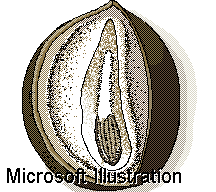
| |
 |
![]()
 I've read that if seeds are vacuum sealed they can last ten years or longer. I
currently have some corn seed not vacuum sealed that are over five years old and
they have a high degree of germination. Don't forget to use non-hybrid seeds for
planting. Humidity is the biggest enemy in saving seeds, so be sure to seal them
well.
I've read that if seeds are vacuum sealed they can last ten years or longer. I
currently have some corn seed not vacuum sealed that are over five years old and
they have a high degree of germination. Don't forget to use non-hybrid seeds for
planting. Humidity is the biggest enemy in saving seeds, so be sure to seal them
well.
Offered by Mike G.
Mother Earth News, Sep/Oct 78
Storage
After harvesting cleaning and drying your seeds store them in air tight containers such as canning jars or coffee cans with plastic lids. Label each container clearly indicating the variety of vegetable and the date of harvest. Then place your jars or cans of seed in a cool dry place. A good rule of thumb for determining if storage conditions are appropriate is that the sum of temperature (in degrees Fahrenheit) and relative humidity (expressed as a percentage) should not exceed 100. For example seed stored at 45°F should not be exposed to a relative humidity that is greater than 55.
Mother Earth News, Vol: 53 Sep/Oct 78
Testing for Viability
If seeds are properly stored they will remain viable (will grow) for anywhere from one to five years ... depending on the type of vegetable. If you have doubts about whether or not some of your seeds will still sprout check em out before you plant them In the garden. Just roll up a few of each of the batches of seeds that you're unsure of between layers of damp cloth or paper towels. Then stand this simple sprouter on end in a jar with a little water in the bottom. In a few days, examine the seeds to determine what percentage have germinated. If - for example - only 50% have sent out shoots, no problem: Just sow twice as many per row as you would had they all been viable. (If the percentage of germination is too small, of course, you will have to discard the seeds and buy yourself a fresh start in that particular plant.)
Mother Earth News, Sep/Oct 1987
Care and Handling
By Nancy Bubel
My own seed-keeping methods are simple. At season's end, I bundle up all my labeled envelopes and small jars of seed, pack them into an old lard can with a tight-fitting lid and stash them in the cold barn over winter. Then at spring planting time, I follow that final but crucial law of the seed keeper: Always save a portion of your seed, no matter how old it is. Then in case of a crop failure, you can replant. A single plant or two from that reserved seed supply can restart your seed collection. That way you can keep alive the personal strain you've bred to suit your own back-yard garden.